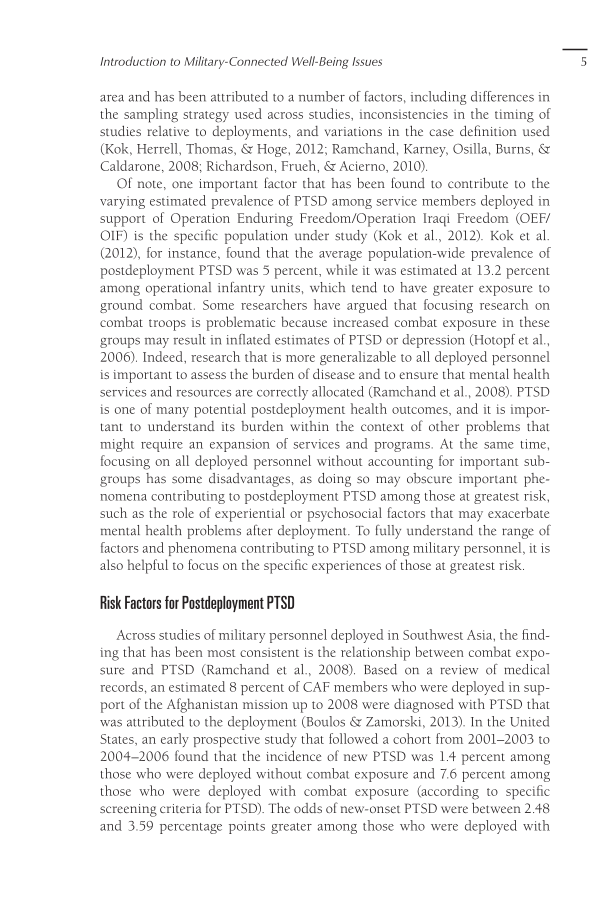Introduction to Military-Connected Well-Being Issues 5 area and has been attributed to a number of factors, including differences in the sampling strategy used across studies, inconsistencies in the timing of studies relative to deployments, and variations in the case definition used (Kok, Herrell, Thomas, & Hoge, 2012 Ramchand, Karney, Osilla, Burns, & Caldarone, 2008 Richardson, Frueh, & Acierno, 2010). Of note, one important factor that has been found to contribute to the varying estimated prevalence of PTSD among service members deployed in support of Operation Enduring Freedom/Operation Iraqi Freedom (OEF/ OIF) is the specific population under study (Kok et al., 2012). Kok et al. (2012), for instance, found that the average population-wide prevalence of postdeployment PTSD was 5 percent, while it was estimated at 13.2 percent among operational infantry units, which tend to have greater exposure to ground combat. Some researchers have argued that focusing research on combat troops is problematic because increased combat exposure in these groups may result in inflated estimates of PTSD or depression (Hotopf et al., 2006). Indeed, research that is more generalizable to all deployed personnel is important to assess the burden of disease and to ensure that mental health services and resources are correctly allocated (Ramchand et al., 2008). PTSD is one of many potential postdeployment health outcomes, and it is impor- tant to understand its burden within the context of other problems that might require an expansion of services and programs. At the same time, focusing on all deployed personnel without accounting for important sub- groups has some disadvantages, as doing so may obscure important phe- nomena contributing to postdeployment PTSD among those at greatest risk, such as the role of experiential or psychosocial factors that may exacerbate mental health problems after deployment. To fully understand the range of factors and phenomena contributing to PTSD among military personnel, it is also helpful to focus on the specific experiences of those at greatest risk. Risk Factors for Postdeployment PTSD Across studies of military personnel deployed in Southwest Asia, the find- ing that has been most consistent is the relationship between combat expo- sure and PTSD (Ramchand et al., 2008). Based on a review of medical records, an estimated 8 percent of CAF members who were deployed in sup- port of the Afghanistan mission up to 2008 were diagnosed with PTSD that was attributed to the deployment (Boulos & Zamorski, 2013). In the United States, an early prospective study that followed a cohort from 2001–2003 to 2004–2006 found that the incidence of new PTSD was 1.4 percent among those who were deployed without combat exposure and 7.6 percent among those who were deployed with combat exposure (according to specific screening criteria for PTSD). The odds of new-onset PTSD were between 2.48 and 3.59 percentage points greater among those who were deployed with
Document Details My Account Print multiple pages
Print
You have printed 0 times in the last 24 hours.
Your print count will reset on at .
You may print 0 more time(s) before then.
You may print a maximum of 0 pages at a time.































































































































































































































































































